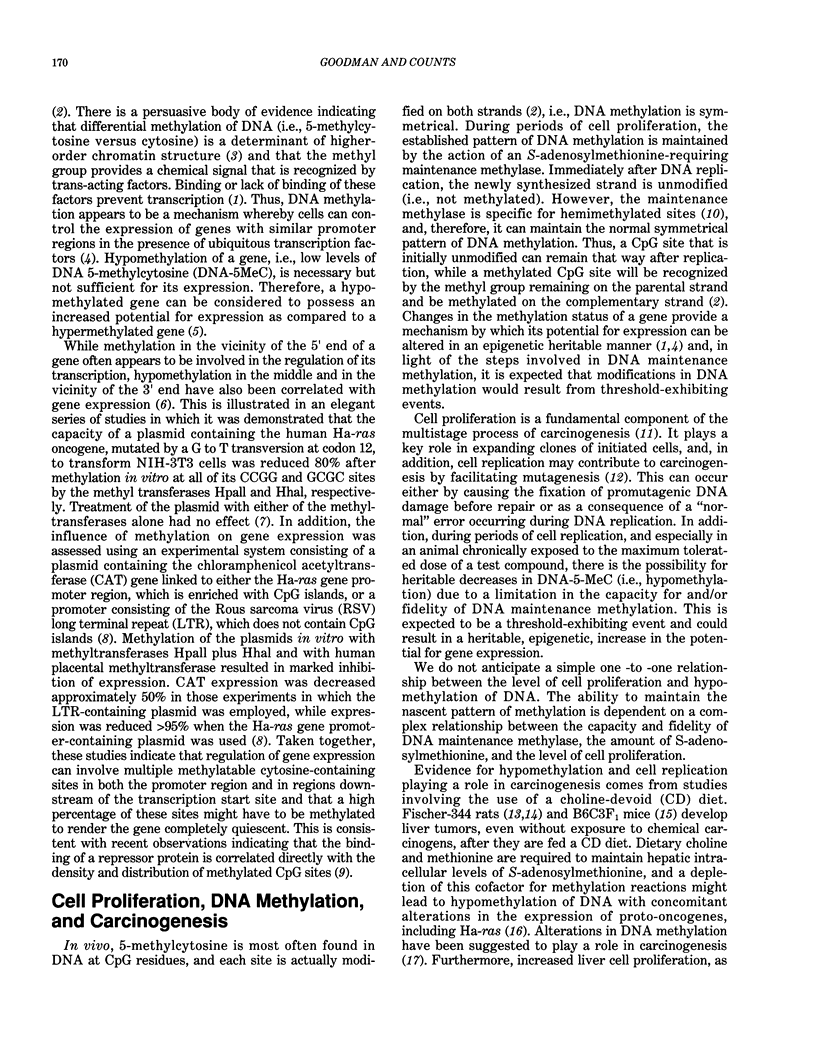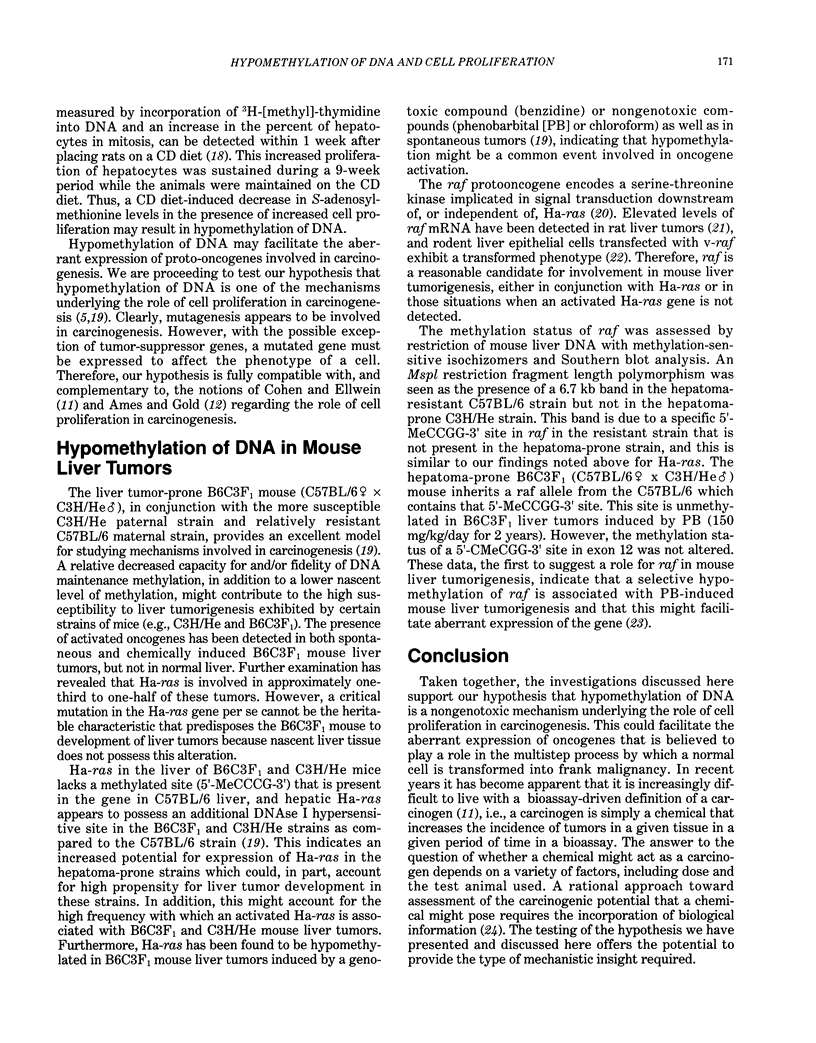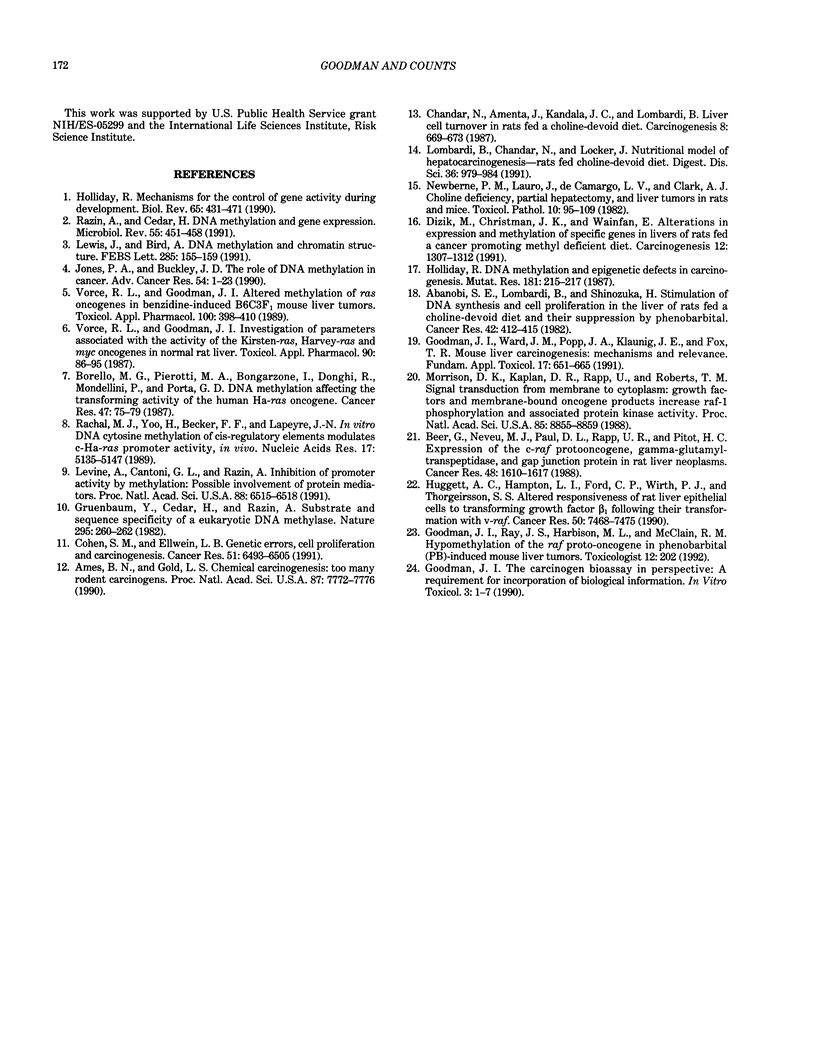Abstract
DNA methylation (i.e., the 5-methylcytosin content of DNA) plays a role in the regulation of gene activity. There is a persuasive body of evidence indicating that differential methylation of DNA (i.e., 5-methylcytosine versus cytosine) is a determinant of chromatin structure and that the methyl group provides a chemical signal that is recognized by trans-acting factors that regulate transcription. Hypomethylation (i.e., low levels of DNA 5-methylcytosine) of a gene is necessary but not sufficient for its expression, and, therefore, a hypomethylated gene can be considered to possess an increased potential for expression as compared to a hypermethylated gene. Cell proliferation is a fundamental component of carcinogenesis. It plays a key role in expanding clones of initiated cells and, in addition, cell replication may contribute to carcinogenesis by facilitating mutagenesis. This can occur either by causing the fixation of promutagenic DNA-damage before repair or as a consequence of a "normal" error occurring during DNA replication. During periods of cell proliferation the established pattern of DNA methylation is maintained by the action of a maintenance methylase following DNA replication. Changes in the methylation status of a gene provide a mechanism by which its potential for expression can be altered in an epigenetic heritable manner, and it is expected that modifications in DNA methylation would result from threshold-exhibiting events.
Full text
PDF



Selected References
These references are in PubMed. This may not be the complete list of references from this article.
- Abanobi S. E., Lombardi B., Shinozuka H. Stimulation of DNA synthesis and cell proliferation in the liver of rats fed a choline-devoid diet and their suppression by phenobarbital. Cancer Res. 1982 Feb;42(2):412–415. [PubMed] [Google Scholar]
- Ames B. N., Gold L. S. Chemical carcinogenesis: too many rodent carcinogens. Proc Natl Acad Sci U S A. 1990 Oct;87(19):7772–7776. doi: 10.1073/pnas.87.19.7772. [DOI] [PMC free article] [PubMed] [Google Scholar]
- Beer D. G., Neveu M. J., Paul D. L., Rapp U. R., Pitot H. C. Expression of the c-raf protooncogene, gamma-glutamyltranspeptidase, and gap junction protein in rat liver neoplasms. Cancer Res. 1988 Mar 15;48(6):1610–1617. [PubMed] [Google Scholar]
- Borrello M. G., Pierotti M. A., Bongarzone I., Donghi R., Mondellini P., Della Porta G. DNA methylation affecting the transforming activity of the human Ha-ras oncogene. Cancer Res. 1987 Jan 1;47(1):75–79. [PubMed] [Google Scholar]
- Chandar N., Amenta J., Kandala J. C., Lombardi B. Liver cell turnover in rats fed a choline-devoid diet. Carcinogenesis. 1987 May;8(5):669–673. doi: 10.1093/carcin/8.5.669. [DOI] [PubMed] [Google Scholar]
- Cohen S. M., Ellwein L. B. Genetic errors, cell proliferation, and carcinogenesis. Cancer Res. 1991 Dec 15;51(24):6493–6505. [PubMed] [Google Scholar]
- Dizik M., Christman J. K., Wainfan E. Alterations in expression and methylation of specific genes in livers of rats fed a cancer promoting methyl-deficient diet. Carcinogenesis. 1991 Jul;12(7):1307–1312. doi: 10.1093/carcin/12.7.1307. [DOI] [PubMed] [Google Scholar]
- Goodman J. I., Ward J. M., Popp J. A., Klaunig J. E., Fox T. R. Mouse liver carcinogenesis: mechanisms and relevance. Fundam Appl Toxicol. 1991 Nov;17(4):651–665. doi: 10.1016/0272-0590(91)90175-4. [DOI] [PubMed] [Google Scholar]
- Holliday R. DNA methylation and epigenetic defects in carcinogenesis. Mutat Res. 1987 Dec;181(2):215–217. doi: 10.1016/0027-5107(87)90098-4. [DOI] [PubMed] [Google Scholar]
- Holliday R. Mechanisms for the control of gene activity during development. Biol Rev Camb Philos Soc. 1990 Nov;65(4):431–471. doi: 10.1111/j.1469-185x.1990.tb01233.x. [DOI] [PubMed] [Google Scholar]
- Huggett A. C., Hampton L. L., Ford C. P., Wirth P. J., Thorgeirsson S. S. Altered responsiveness of rat liver epithelial cells to transforming growth factor beta 1 following their transformation with v-raf. Cancer Res. 1990 Dec 1;50(23):7468–7475. [PubMed] [Google Scholar]
- Jones P. A., Buckley J. D. The role of DNA methylation in cancer. Adv Cancer Res. 1990;54:1–23. doi: 10.1016/s0065-230x(08)60806-4. [DOI] [PubMed] [Google Scholar]
- Levine A., Cantoni G. L., Razin A. Inhibition of promoter activity by methylation: possible involvement of protein mediators. Proc Natl Acad Sci U S A. 1991 Aug 1;88(15):6515–6518. doi: 10.1073/pnas.88.15.6515. [DOI] [PMC free article] [PubMed] [Google Scholar]
- Lewis J., Bird A. DNA methylation and chromatin structure. FEBS Lett. 1991 Jul 22;285(2):155–159. doi: 10.1016/0014-5793(91)80795-5. [DOI] [PubMed] [Google Scholar]
- Lombardi B., Chandar N., Locker J. Nutritional model of hepatocarcinogenesis. Rats fed choline-devoid diet. Dig Dis Sci. 1991 Jul;36(7):979–984. doi: 10.1007/BF01297151. [DOI] [PubMed] [Google Scholar]
- Morrison D. K., Kaplan D. R., Rapp U., Roberts T. M. Signal transduction from membrane to cytoplasm: growth factors and membrane-bound oncogene products increase Raf-1 phosphorylation and associated protein kinase activity. Proc Natl Acad Sci U S A. 1988 Dec;85(23):8855–8859. doi: 10.1073/pnas.85.23.8855. [DOI] [PMC free article] [PubMed] [Google Scholar]
- Rachal M. J., Yoo H., Becker F. F., Lapeyre J. N. In vitro DNA cytosine methylation of cis-regulatory elements modulates c-Ha-ras promoter activity in vivo. Nucleic Acids Res. 1989 Jul 11;17(13):5135–5147. doi: 10.1093/nar/17.13.5135. [DOI] [PMC free article] [PubMed] [Google Scholar]
- Razin A., Cedar H. DNA methylation and gene expression. Microbiol Rev. 1991 Sep;55(3):451–458. doi: 10.1128/mr.55.3.451-458.1991. [DOI] [PMC free article] [PubMed] [Google Scholar]
- Vorce R. L., Goodman J. I. Altered methylation of ras oncogenes in benzidine-induced B6C3F1 mouse liver tumors. Toxicol Appl Pharmacol. 1989 Sep 15;100(3):398–410. doi: 10.1016/0041-008x(89)90288-3. [DOI] [PubMed] [Google Scholar]
- Vorce R. L., Goodman J. I. Investigation of parameters associated with activity of the Kirsten-ras, Harvey-ras, and myc oncogenes in normal rat liver. Toxicol Appl Pharmacol. 1987 Aug;90(1):86–95. doi: 10.1016/0041-008x(87)90309-7. [DOI] [PubMed] [Google Scholar]


